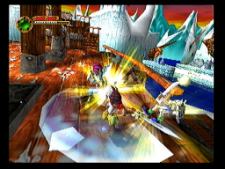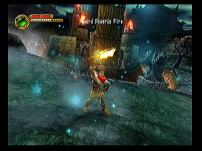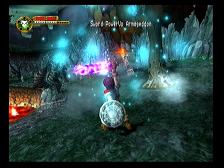Maximo: Ghosts and Glory for the Playstation 2
brings Capcomís classic Ghosts Ďn Goblins series to the present day. While
many of the original enemies and locales make return appearances in the Maximo,
a 3D environment and state-of-the-art graphics lend it a contemporary feel. Read
our review to find out how the tight controls, addictive gameplay and solid
level design makes for an exceptional update.
More than a little Inspired by the classic Ghosts Ďn
Goblins series, Capcomís Maximo takes the spirit of those games and
transplants them into a contemporary 3D environment. While retaining the feel
and atmosphere of the series, itís not a direct sequel. Fans of the original
will find that there are enough homages to the past to make it fit in with the
series nicely. For example, the series original musical score has been
re-orchestrated and mixed to give it a more epic feel. Luckily, the main mission
of the game has remained unchanged, but why would Capcom mess with a successful
formula in the first place? This is more a spin-off that has enough of the
original to satisfy fans but also adds new elements to the gameplay that take
advantage of the 3D space.
As the game begins, players are introduced
to Arthurís successor, Maximo. As the king, your mission is to save the
princess from the evil wizard who is holding her captive. The wizard has sent
you to another dimension where you meet the cipher of Death. The Cipher allows
you to live as long as you help him to defeat the wizard whoís unleashed the
dead. Once you regain your mortal form, youíll find your old kingdom has been
transformed into the domain of many creepy undead enemies. During this quest youíll
face a variety of enemies including zombies and skeletons. Some of the classic
GNG enemies also make return appearances Ė itís nice to see the blue birds,
treasure chests and other classic elements back. The cool thing is that Maximo
feels like the older GNG series but the 3D perspective lends the game a unique
feel.
At first, Maximo has only his standard sword to use as a weapon which is quite
effective at slicing through enemies. In addition, Maximo can do cool double
jumps, crawl and crouch around, plus he has a variety of moves he can use with
his sword. Players can also use Maximoís shield to guard against attacks, bujt
this only works a few times. So overall, he has a lot more flexibility than
normal. However, there are times when youíre faced with multiple enemies and
harder opponents that nee more than these standard sets of moves to beat. The
good news is that you can also use some special abilities such as a flaming
sword, devastating super attacks, and you can also gain the ability to throw
Maximoís shield. Armor plays a big role in the game as well, as players
collect upgrades in the armor to add to his ability. If you takes too many hits,
his armor degrades until heís nearly naked clad only in his boxer shorts. This
should sound familiar to fans of the original and its nice to see that this
quirky aspect of the series hasnít been discarded.
 Maximo
can purchase items and upgrades using coins and jewels he finds along the way
Ė this is important and players should never pass up a coin since many of the
items are expensive. One of the locations where Maximo can find coins are in the
many treasure chests scattered throughout the levels. Some of these can be
opened easily, while others require keys. Additionally, and in another nod to
the classic game somtimes the chests open to reveal a surprise in the form of
snapping jaws that chases after Maximo. This is really cool and adds to the
slapstick humor of the game. Another cool feature is that the chests can also,
once in a great while, open to reveal wizards. If youíre familiar with the GNG
series, you know what happens next. Maximo is either transformed into a helpless
baby or a feeble old man. I loved this part of the game and its quite funny in
the way its implemented. And just like the original game, Maximo can also gain
an upgrade to golden armor as well. This is all quite cool, but there have been
some additions to thes series as well that make it seem more modern.
Maximo
can purchase items and upgrades using coins and jewels he finds along the way
Ė this is important and players should never pass up a coin since many of the
items are expensive. One of the locations where Maximo can find coins are in the
many treasure chests scattered throughout the levels. Some of these can be
opened easily, while others require keys. Additionally, and in another nod to
the classic game somtimes the chests open to reveal a surprise in the form of
snapping jaws that chases after Maximo. This is really cool and adds to the
slapstick humor of the game. Another cool feature is that the chests can also,
once in a great while, open to reveal wizards. If youíre familiar with the GNG
series, you know what happens next. Maximo is either transformed into a helpless
baby or a feeble old man. I loved this part of the game and its quite funny in
the way its implemented. And just like the original game, Maximo can also gain
an upgrade to golden armor as well. This is all quite cool, but there have been
some additions to thes series as well that make it seem more modern.
One of the ways that the game has changed is in the way
the levels unfold. Itís no longer a strictly linear quest because Maximo is
structured so that after the first level, players can then move into a central
area where they can save or transport to other levels.This gives Maximo a much
less structured feel and makes the gameplay feel a lot more open-ended. This
allows you play various levels in the order you want and you can save between
levels in the main areaís reflecting pool. While finding the pools isnít
difficult, trying to time when you want to save can be a bit hard. Players also
have to factor in the fact that saving your progress this is expensive as well,
costing 100 coins per move. This means youíll have to accumulate as many as
possible during each mission and use the coins wisely during each level and not
waste them on useless extras.
 Once
all the levels in the area have been completed, a castle opens up and you can
face the boss enemy in a final battle. These confrontations can be quite
difficult and you may need to fight a boss multiple times in order to beat them.
The good news is that there are some familiar faces here, so GNG veterans may
have and advantage in knowing kind of what to expect. The mini-levels themselves
are short yet challenging, with loads of enemies, hidden areas and unexpected
surprises throughout. Sometimes this can be annoying as the ground unexpectedly
gives way under your feet, which can be aggravating. Luckily, this usually
happens only once at a time, unless youíre really stupid. While the missions
are short, there are usually a lot of skeletons and ghosts to battle. This
sounds easier than it is because there are several types of skeletons and
monsters on each level, and each one of these has different attack patterns.
Players will also have to be careful to avoid the blue Ravens who steal their
koins.
Once
all the levels in the area have been completed, a castle opens up and you can
face the boss enemy in a final battle. These confrontations can be quite
difficult and you may need to fight a boss multiple times in order to beat them.
The good news is that there are some familiar faces here, so GNG veterans may
have and advantage in knowing kind of what to expect. The mini-levels themselves
are short yet challenging, with loads of enemies, hidden areas and unexpected
surprises throughout. Sometimes this can be annoying as the ground unexpectedly
gives way under your feet, which can be aggravating. Luckily, this usually
happens only once at a time, unless youíre really stupid. While the missions
are short, there are usually a lot of skeletons and ghosts to battle. This
sounds easier than it is because there are several types of skeletons and
monsters on each level, and each one of these has different attack patterns.
Players will also have to be careful to avoid the blue Ravens who steal their
koins.
One of the biggest changes in Maximo is the system of
upgrades and abilities which is now much more elaborate. Along the way there are
some power-ups which can aid you in your progress. You can find many upgrades
and health potions throughout each level but thereís a catch. For every level
of armor you get, another power-bar section appears giving Maximo the ability to
take more hits. This is important to understand because the relationship is not
immediately apparent. Youíll also have to use the sword and shield upgrades
wisely as well, since both have special abilities that can only sustain a
limited number of hits so using these wisely is important. Another thing to keep
your eyes on are the lock boxes which contain all the abilities youíve earned,
such as higher jumps or shield throwing abilities. You can either buy these or
win them by defeating enemies in battle. There are only a limited number of
spaces in your locks but these canít be lost when you lose a life. As you can
tell, keeping track of all this can be a pain at times, but the system generally
works well. With all of this going on, itís no surprise that mastering each
level requires some patience and practice. Itís quite rewarding however, since
each one has secret areas and hidden paths and it takes time to thoroughly
explore these many different paths.
Maximoís excellent production values are highlighted
by its brilliant anime-style character designs and fluid animation, not to
mention the beautiful, detailed environments. The game looks amazingly good and
has a great cartoon feel to it throughout. While its dark and creepy, its never
excessively violent and the attacks seem more slapstick than anything else. One
of the best aspects of the game is that the classic theme from the original
games has returned in Maximo, though its been made more elaborate thanks to the
full orchestra implementation. The sound effects are decent as well and add to
the brilliant music to work well together in creating an evocative atmosphere.
Overall, Maximo is one of the better looking platform games to come out for the
PS2 and makes good use of the systemís hardware.
 The
Ghosts Ďn Goblins lineage shows most impressively in its excellent controls
and tight gameplay. Moving and attacking is easy and fun because of the
straightforward approach and simple level design. While some of the platforms
are difficult to navigate, there not impossible because the control is tight and
responsive. This allows the character to have plenty of flexibility without
becoming overly complicated, allowing you to concentrate on the task at hand.
While the high polish in the gameplay is generally good, Maximo suffers from
some camera problems, which often end up in awkward positions. This makes it
frequently difficult to effectively judge your position in comparison to the
next platform, causing you to leap to your death unnecessarily. This can make
the game incredibly frustrating, and though you can push the shift keys to gain
a direct behind the character perspective, itís still not perfect but
acceptable. However, this is an excellent platform game, which is both
challenging and fun. Itís nice to see that the seriesí difficulty hasnít
been watered down for the Ďmainstreamí players, which might frustrate those
who donít like a challenge. However, itís this very difficulty that makes
Maximo so satisfying. From a technical standpoint, itís not perfect and
suffers from too many camera issues. That said, the arcade style gameplay has
the classic arcade balance between difficulty and simplicity, making it quite an
addictive game. Maximo may not be the easiest game in the world but it plays
smoothly and rarely resorts to cheap moves. While itís got many new elements
and much more sophisticated abilities and inventory management systems, the
spirit of the original Ghosts ní Goblins series lives on. The many players who
loved the original series will find that far from being a rehash, Maximo
resurrects the classic gameplay without losing the essential elements of its
appeal. This is a solid update however, and even those who never played the
original should find plenty to enjoy as well.
The
Ghosts Ďn Goblins lineage shows most impressively in its excellent controls
and tight gameplay. Moving and attacking is easy and fun because of the
straightforward approach and simple level design. While some of the platforms
are difficult to navigate, there not impossible because the control is tight and
responsive. This allows the character to have plenty of flexibility without
becoming overly complicated, allowing you to concentrate on the task at hand.
While the high polish in the gameplay is generally good, Maximo suffers from
some camera problems, which often end up in awkward positions. This makes it
frequently difficult to effectively judge your position in comparison to the
next platform, causing you to leap to your death unnecessarily. This can make
the game incredibly frustrating, and though you can push the shift keys to gain
a direct behind the character perspective, itís still not perfect but
acceptable. However, this is an excellent platform game, which is both
challenging and fun. Itís nice to see that the seriesí difficulty hasnít
been watered down for the Ďmainstreamí players, which might frustrate those
who donít like a challenge. However, itís this very difficulty that makes
Maximo so satisfying. From a technical standpoint, itís not perfect and
suffers from too many camera issues. That said, the arcade style gameplay has
the classic arcade balance between difficulty and simplicity, making it quite an
addictive game. Maximo may not be the easiest game in the world but it plays
smoothly and rarely resorts to cheap moves. While itís got many new elements
and much more sophisticated abilities and inventory management systems, the
spirit of the original Ghosts ní Goblins series lives on. The many players who
loved the original series will find that far from being a rehash, Maximo
resurrects the classic gameplay without losing the essential elements of its
appeal. This is a solid update however, and even those who never played the
original should find plenty to enjoy as well.

